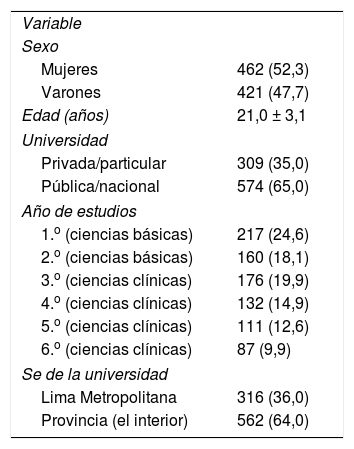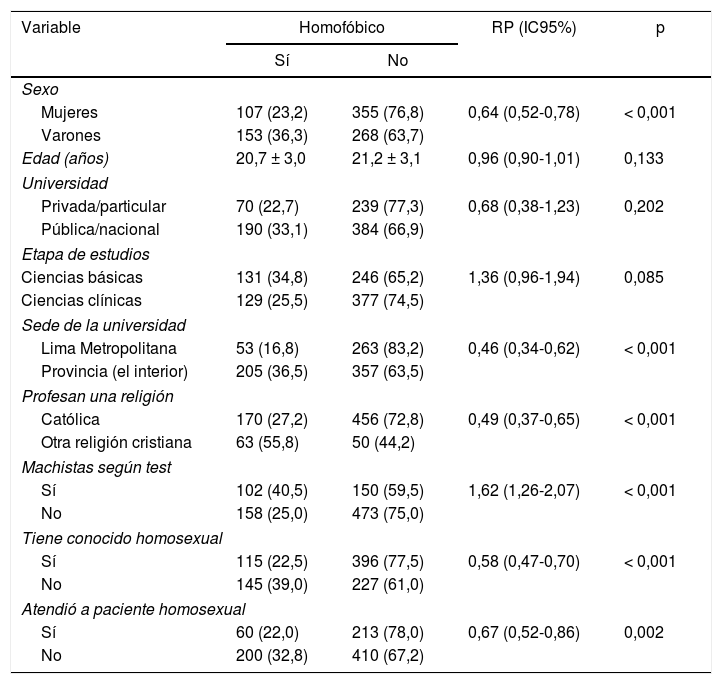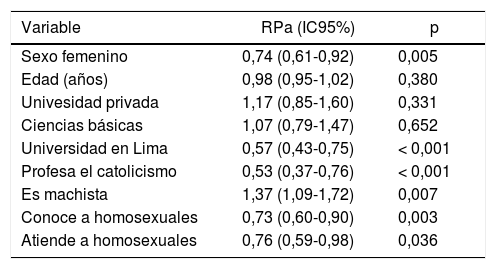Las consecuencias de la homofobia pueden afectar a la integridad y la salud mental y física de los individuos homosexuales en la sociedad. En Perú hay escasos estudios que hayan evaluado la homofobia en la población médico-estudiantil.
ObjetivoDeterminar los factores sociales, educativos y culturales asociados con la homofobia entre estudiantes de Medicina peruanos.
MétodosSe realizó un estudio de tipo transversal analítico en 12 sedes de Medicina humana peruanas. Se definió homofobia según un test validado, que se asoció con otras variables. Se obtuvieron estadísticos de asociación.
ResultadosLas 4 universidades de Lima obtuvieron menores porcentajes de alumnos homofóbicos (15–20%) que las universidades del interior del país (22–62%). Al realizar el análisis multivariable, disminuyeron la frecuencia de homofobia: ser mujer (RPa = 0,74; IC95%, 0,61-0,92; p = 0,005), estudiar en una universidad de Lima (RPa = 0,57; IC95%, 0,43-0,75; p < 0,001), profesar la religión católica (RPa = 0,53; IC95%, 0,37-0,76; p < 0,001), conocer a un homosexual (RPa = 0,73; IC95%, 0,60-0,90; p = 0,003) y haber atendido a un paciente homosexual (RPa = 0,76; IC95%, 0,59-0,98; p = 0,036); en cambio, ser machista aumentó la frecuencia de homofobia (RPa = 1,37; IC95%, 1,09-1,72; p = 0,007), ajustado por 4 variables.
ConclusionesLa homofobia fue menos frecuente entre las mujeres, los que estudiaban en la capital, los que profesan el catolicismo y los que conocen/han atendido a un homosexual; por el contrario, los machistas fueron más homofóbicos.
The consequences of homophobia can affect the integrity, mental and physical health of homosexual individuals in society. There are few studies in Peru that have evaluated homophobia in the medical student population.
ObjectiveTo establish the social, educational and cultural factors associated with homophobia among Peruvian medical students.
MethodsA cross-sectional analytical study was conducted in 12 medicine schools in Peru. Homophobia was defined according to a validated test, which was associated with other variables. Statistical associations were identified.
ResultsThe lowest percentages of homophobic students (15–20%) were found in the four universities in Lima, while universities in the interior of the country had the highest percentages (22–62%). Performing a multivariate analysis, we found that the frequency of homophobia was lower for the following variables: the female gender (PRa=0.74; 95% CI, 0.61–0.92; p=0.005), studying at a university in Lima (PRa=0.57; 95% CI, 0.43–0.75; p<0.001), professing the Catholic religion (PRa=0.53; 95% CI, 0.37–0.76; p<0.001), knowing a homosexual (PRa=0.73; 95% CI, 0.60–0.90; p=0.003) and having treated a homosexual patient (PRa=0.76; 95% CI, 0.59–0.98; p=0.036). In contrast, the frequency of homophobia increased in male chauvinists (PRa=1.37; 95% CI, 1.09–1.72; p=0.007), adjusted by four variables.
ConclusionsHomophobia was less common in women, in those who study in the capital, those who profess Catholicism and those who know/have treated a homosexual. In contrast, male chauvinists were more homophobic.
Artículo
Comprando el artículo el PDF del mismo podrá ser descargado
Precio 19,34 €
Comprar ahora









